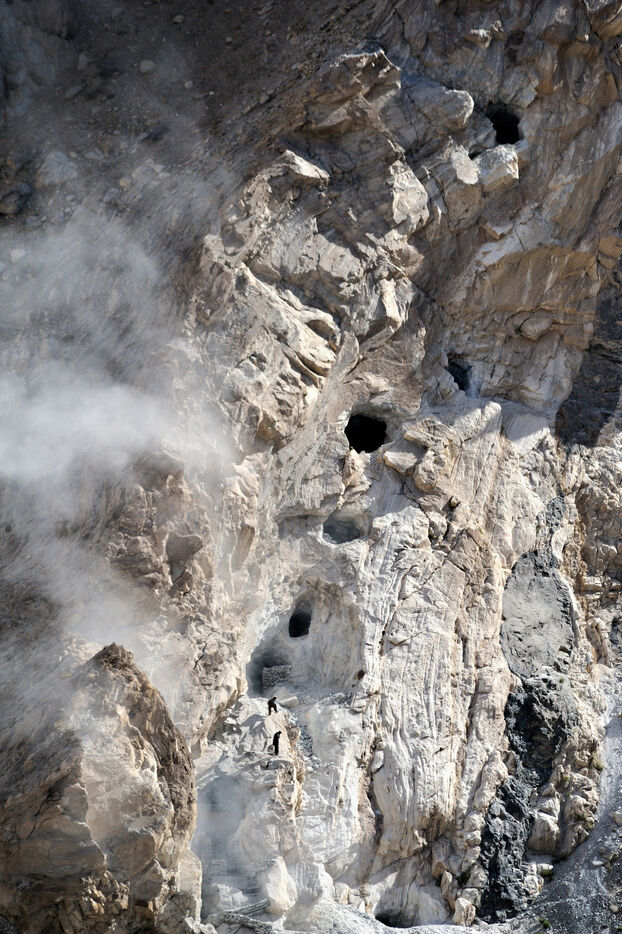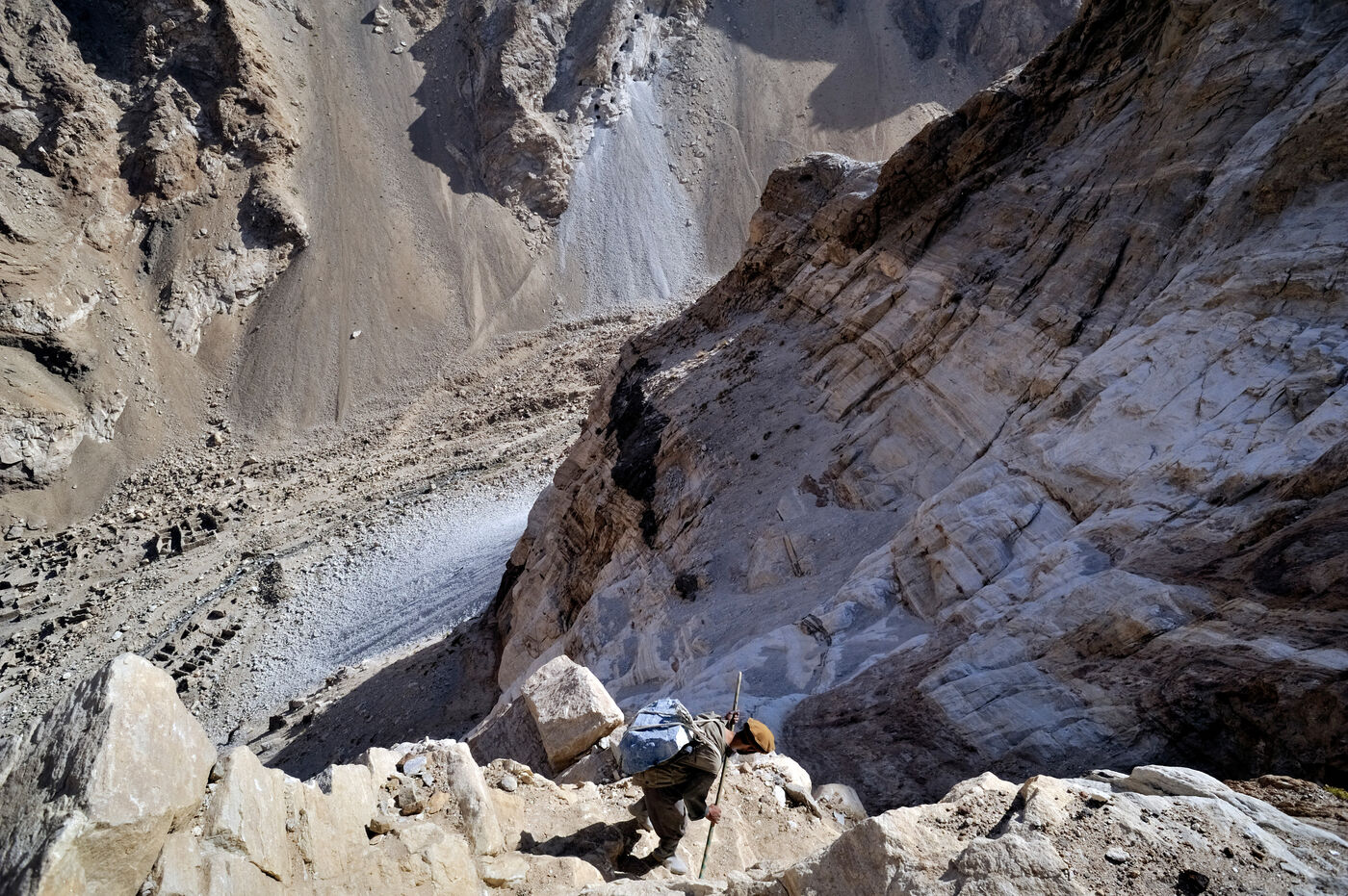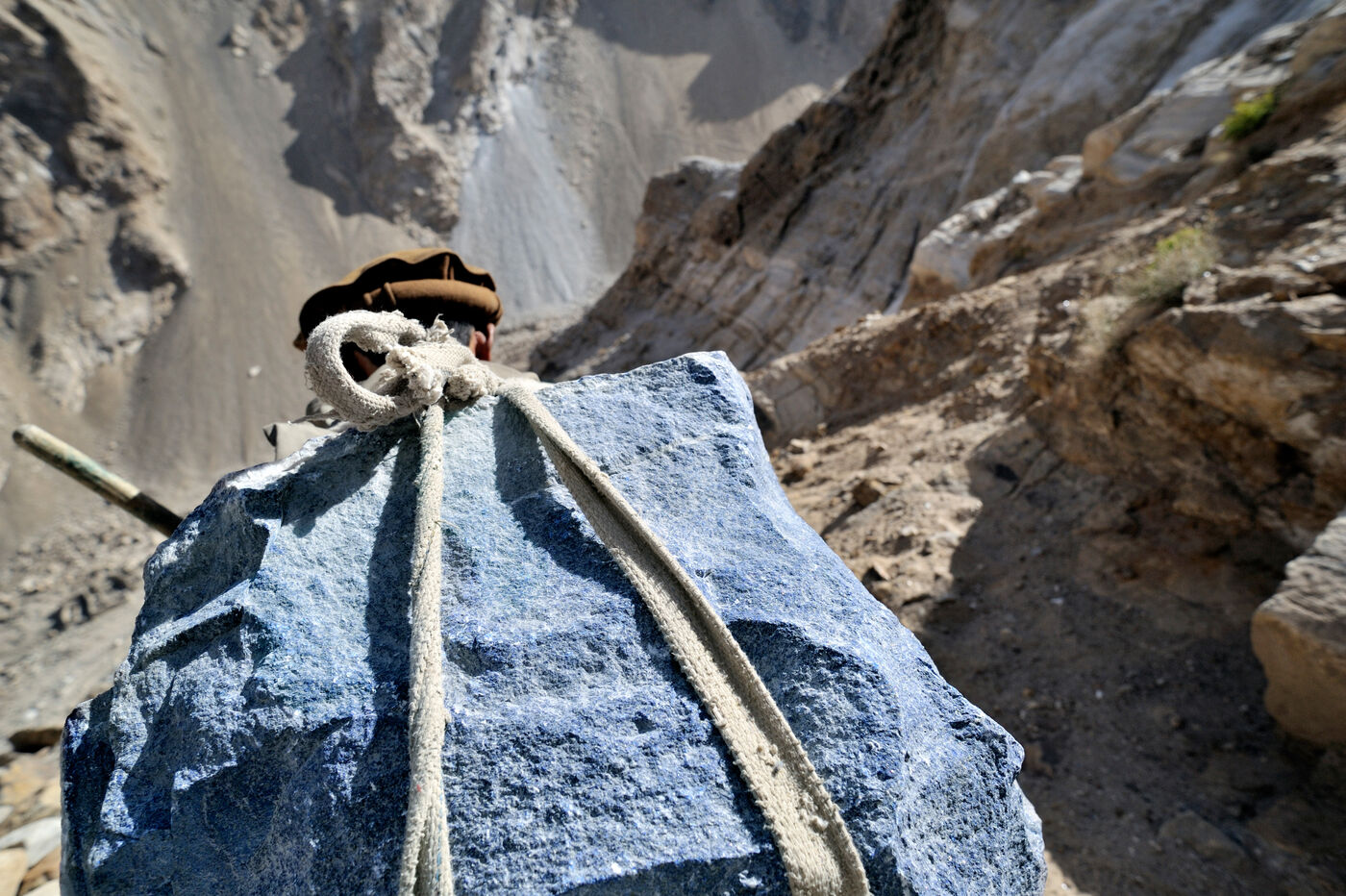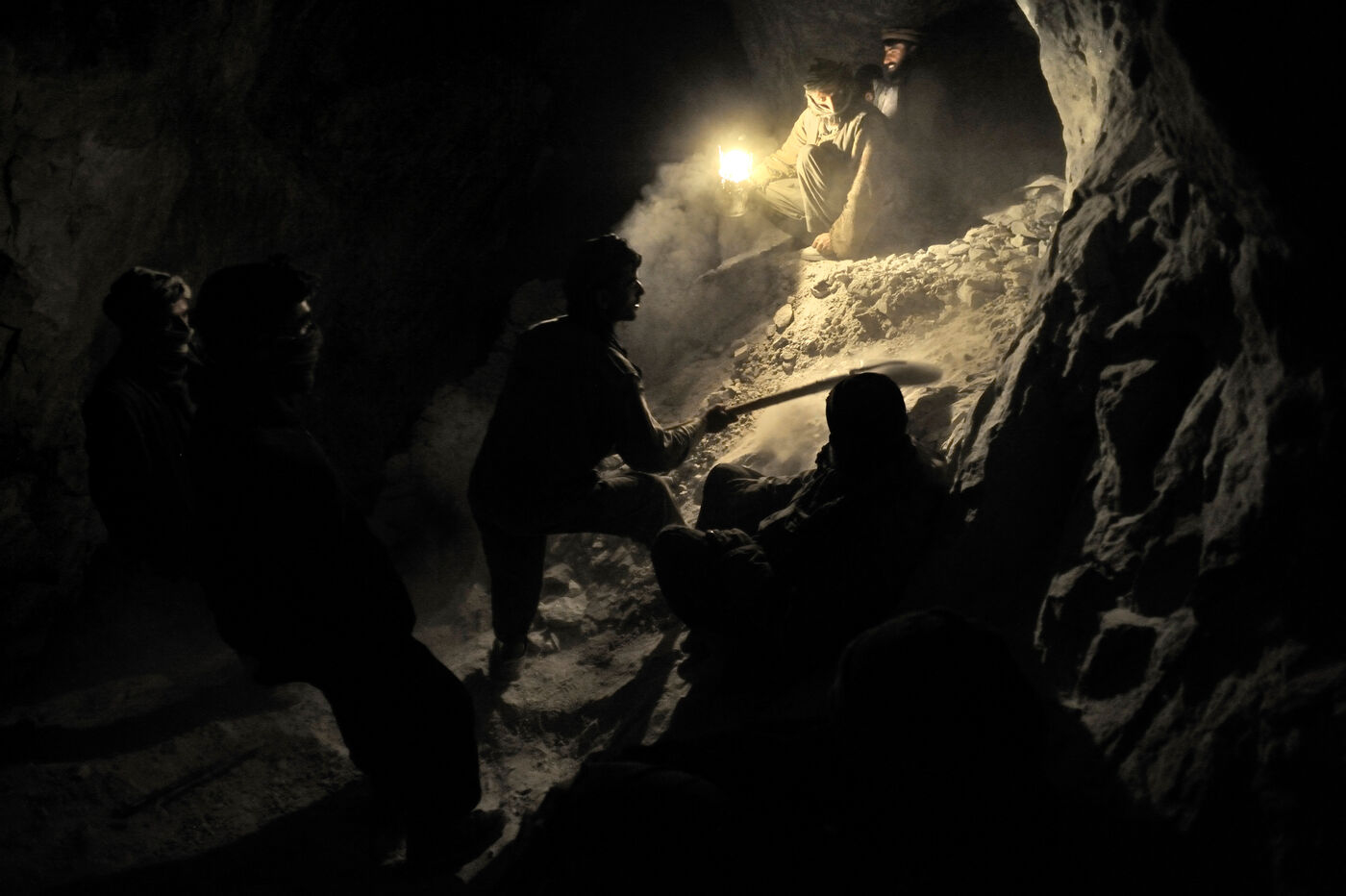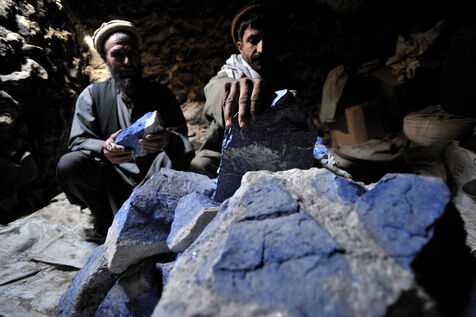Lapis lazuli, le trésor bleu des afghans
LA FORTUNE BLEUE DE L'AFGHANISTAN
Depuis plus de 6500 ans, la quête laborieuse d’une pierre semi-précieuse, le lapis lazuli, ne s’est jamais interrompue. Entre dynamite et sueur, entre luxe et conflits, l’histoire du Lapis lazuli a traversé les époques et mêlé les destins des plus grands dignitaires de l’Histoire. Des Sumériens au commandant Massoud, de Michel-Ange à Marie-Antoinette, tous ont partagé la fascination pour ce bleu profond et mystérieux.
Une explosion brise le silence des montagnes du Badakhshan, puis une autre, et encore sept autres détonations, chacune suivie d’un écho assourdissant qui donne au visiteur l’impression d’être au cœur de violents combats. Pourtant, ici, point de guerriers, seulement des survivants qui luttent pour leur pain quotidien. Ils sont en quête du célèbre lapis lazuli, une pierre semi-précieuse exploitée en Afghanistan depuis 6500 ans. Une gemme d’un bleu profond, enfouie dans la roche afghane, entre les veines de marbre.
Hassan est l’un de ces chercheurs de l'extrême. C’est lui qui, d’un geste précis, a allumé les sept bâtons de dynamite plantés dans la roche par son équipe, composée de membres de sa propre famille. La mine étant creusée trop profondément dans la montagne, il leur faudrait trop de temps pour en sortir avant l’explosion. Alors, les hommes se terrent dans une alcôve creusée dans la roche, là où ils entreposent aussi le moteur de leur marteau-piqueur. Lorsque la poussière retombe, ils restent immobiles une dizaine de minutes, échangent quelques mots et se rappellent qu’ils ont quitté leur village depuis cinq ans, sans ressources. Chacun ajuste son foulard serré autour du crâne, seule protection contre la poussière. Aucune autre contre les chutes de pierre. Mais rien ne saurait éteindre leur espoir de faire fortune dans les entrailles de l’Hindou Kouch, cette chaîne de montagnes qui s’étend au nord de la frontière afghano-pakistanaise et dont les sommets atteignent les 6000 mètres.
Hassan n’a que vingt ans. Il est arrivé à la mine à quinze ans et n’est jamais retourné voir ses parents. Ce jeune homme au visage couvert de poussière vit ici et ne rentrera que lorsqu’il sera devenu riche, lorsqu’il pourra être utile à sa famille. Il confie : « Ici, c’est encore pire que là-bas. Il n’y a souvent rien à manger, mais tant que nous n’avons rien à ramener à nos familles, nous devons rester. »
En face de la mine de Hassan, Chupon travaille dans un autre puits avec une autre équipe. Ils viennent du même village, Gerem, situé à 100 kilomètres, soit huit heures de route. Il a pu rentrer chez lui il y a neuf mois. Il a hésité à revenir à la mine, mais dit d’un ton fataliste : « Je n’ai pas le choix. Dans mon village, il n’y a pas de travail. » Le mineur, au visage rond d’une cinquantaine d’années, me fait comprendre qu’il a dû abandonner les siens, les confiant à la grâce de Dieu, faute de pouvoir subvenir à leurs besoins.
Autour de la mine, la vie est un combat quotidien. Pourtant, la guerre s’est arrêtée ici depuis 2001. Mais l’aridité, le froid et la misère sont des ennemis redoutables. L’hiver, qui dure cinq mois, isole la province du reste du pays et empêche toute culture agricole, amenant les Nations Unies à acheminer de la nourriture lorsque l’accès aux villages est possible. La pauvreté est ici extrême : au Badakhshan, 6,5 % des femmes meurent en donnant la vie. C’est l’un des pires endroits au monde pour accoucher, répètent les ONG présentes sur place.
Pour se rendre au Badakhshan, le moyen le plus simple est d’emprunter un petit avion Antonov, qui ne vole que lorsque le temps est clément, un luxe réservé aux journalistes, aux humanitaires et à quelques Afghans privilégiés. L’appareil se faufile entre les montagnes, incapable de survoler tous ces sommets. Dès l’apparition des nuages en octobre, la route devient la seule voie d’accès. Une piste sinueuse, bordée de précipices.
Les gemmes comme "caisse de guerre"
L’histoire du Lapis lazuli ne peut être dissociée de la situation actuelle de l’Afghanistan au cours des trente dernières années et de la guerre qui ravage ce pays d’Asie centrale. Cette pierre précieuse qui suscite tant de passions a également servi de monnaie d’échange pour financer des combats sanglants qui rythment la vie des Afghans.
Après le retrait des troupes soviétiques d’Afghanistan en 1989, le célèbre commandant Massoud a commencé à taxer le commerce du lapis-lazuli et des émeraudes afin de financer l’achat d’armes auprès de l’Iran et de la Russie pour lutter contre les talibans. Ces derniers ont pris le contrôle de Kaboul en 1996. Massoud a alors poursuivi la lutte, se repliant vers les provinces du nord-est.
Durant les dernières années de sa vie, avant son assassinat par les talibans le 9 septembre 2001, l’armée de Massoud, le Front uni, également connu sous le nom d’Alliance du Nord, contrôlait presque entièrement la vente de pierres précieuses sur le marché international. Dans cette guerre coûteuse, la taxation de l’opium constituait l’autre source majeure de revenus pour les deux factions armées.
Selon une étude réalisée en 2000 par Ahmed Rashid, essayiste pakistanais et spécialiste des guerres afghanes, 60 % du financement de l’Alliance du Nord provenait du commerce des pierres précieuses et semi-précieuses, tandis que 30 à 40 % étaient issus de la vente d’opium. Le budget de guerre était alors estimé à 60 millions de dollars, sans compter les donations étrangères.
Aujourd’hui, le commerce du Lapis lazuli est plus pacifique. Toutefois, "la guerre et la corruption qui gangrènent quotidiennement toutes les régions afghanes compliquent l’exploitation du Lapis lazuli", m’a confié M. Shams, un riche grossiste en pierres précieuses rencontré sur la route entre Kaboul et la province du Badakhshan. "Nous avons peu de moyens. Mais nous avons du lapis, de l’argent, des rubis, du cuivre, du marbre, du charbon… (…) Nous avons besoin de routes et d’une meilleure organisation."
En effet, l’un des principaux problèmes de tous les projets en Afghanistan est l’absence de politique forte. Le ministère des Mines, basé à Kaboul, est éloigné de ses exploitations et de ses ouvriers. Il préfère signer des contrats avec des entreprises chinoises, car cela est plus simple.
Gageons que les efforts des armées étrangères présentes en Afghanistan s’orienteront bientôt vers les provinces les plus reculées, afin de développer une activité économique saine, dirigée par les Afghans eux-mêmes. Un commerce équitable dans une économie prospère : n’est-ce pas là le meilleur des processus de paix ?
Note : Le terme "lapis-lazuli" vient du latin et de l’arabe. "Lapis" signifie "pierre" en latin, tandis que "lazuli" signifie "bleu" en arabe. En persan, cette gemme est appelée lajwârd. Le lapis-lazuli provient presque exclusivement du Badakhshan. On en trouve également en Sibérie et au Chili, mais d’une qualité bien inférieure.
Lapis Lazuli, an afghan blue fortune
THE AFGHAN BLUE FORTUNE
For more than 6500 years, the laborious quest of a semi-precious stone, the Lapis lazuli, has never stopped. Among the dynamite and the sweat, or among the luxury and the wars, the story of the lapis lazuli has involved the great dignitaries of History. The Sumerians, the Commander Massood or Michel-Ange and Marie-Antoinette, all of them have in common the colourful midnight blue of the lapis lazuli.
An explosion shatters the silence of the mountains of Badakhshan, an isolated province in the north-east of arid Afghanistan, then two, then seven blasts, each of them followed by a deafening echo which makes the visitor think he is in the midst of fierce fightings. Though, here there is no fighter, but survivors struggling to earn their daily bread. They are in search of the famous lapis lazuli, a semi-precious stone exploited in Afghanistan for 6500 years. A gem of a deep blue found only here in the Afghan rock between the veins of marble.
Hassan is one of these seekers of the « extreme ». It was him who set fire to seven pieces of dynamite planted into the rock by his team, members of his family. The mine being set too deeply into the rock, so it would take them too much time to get out during the explosion. The men are hiding in one of the nooks of their tunnels, in the same place they store the engine of their big drill. While the dust comes down, the miners sit still for about ten minutes, exchanging a few words and remembering that they have left their villages without any means for nearly five years. Each of them tidies up the scarf which fits tightly his skull, the sole protection against dust. No protection either against the falling of rocks. But nothing can make them lose hope to make a fortune in the bowels of the Hindu Kush, the mountain range crossing the north of Afghan-Pakistani border, the summits of which tower at about 6000 meters.
Hassan is just twenty years old. He arrived at the mine when he was fifteen. He never went back to see his parents. This young man with he dusty face lives here and will go back only once he becomes rich, and useful to his family. The young man explains : « Here, it is even worse than down there, there is often nothing to eat, but as long as we don’t have anything to bring back to our families we have to stay here. » On the opposite side of the mine of Hassan, Chupon works in another hole with another team. They are relatives living in the same village, Gerem, located 100 km away, that is an eight hour drive. He was able to go to see his family nine months ago. He hesitated over coming back to the mine but he tells me in a fatalistic mood : « I have no choice. In my village, there is no work ». The miner with a chubby face, about 50 years old, lets me understand that he abandoned his family, putting their « fate to God’s grace », because of not being able to provide for his family.
The area around the mine is one of the places in Afghanistan where to live is a daily struggle. And yet, war stopped since 2001, with the arrival of the German Army as part of the operation of NATO. Aridity, the cold weather and poverty are the enemies here. The government of Badakhshan counted 60 deaths, last year caused by the cold for the five months of winter during which the province is cut off from everything and allows only one crop a year, binding the United Nations to supply food when access to the village is possible. A typical figure of poverty : in Badakhshan, 6,5 per cent of women die while giving life, the worst place on earth to give birth repeat the NGOs working there.
To get to Badakhshan, the easiest way is to take a small Antonov plane operating when the weather is mild, a luxury that only journalists, aid-workers and a few high-placed Afghans can afford. The plane tries to find its way between mountains because it can not fly over all those peaks. As soon as thick clouds come out in october, the road is the only opening to the outside. A winding track between ravines and tunnels partly asphalted.
Blue sweat
Beads of sweat stand out endlessly on Ehsan’s brow. He has been walking for more than an hour in an exhausting sun at 3000 meters high. Ehsan is halfway. He goes to the village, zigzaging between the slippery and dusty rocks. His steps are slow ; secured by two straps, he carries on his back a block of 100 kilos (200 lbs). The stone is of a bright blue. But no one dares to touch it for fear of making this frail and dehydrated porter stumble. Lapis lazuli is here in front of our eyes, as beautiful as it is dangerous.
Once in the village, Ehsan will sell his stone to Hamidullah, a wholesaler exercising as well the job of policeman in the mine! Ehsan won’t receive the real price of his stone, neither a salary. The miners work for an owner who will pay them the equivalent of perhaps only one to two kilos when their workers find a block of stone similar to the one found by Ehsan. That represents about 20.000 Afghanis , equivalent to 400 dollars or 300 euros at best. The price will be divided into two if the intensity of the blue is ordinary.
The owners are away from the mine, living lower down when they are not at Kabul trading their goods. They know their workers can not cheat. On those sharp moutains, there is only one road to leave the mine : nothing, nobody can escape. Ehsan will have to divide the commission he received with the miners who have worked to quarry out this beautiful blue block. The maintenance fees and fuel are paid by the workers. At the end, a miner can expect to earn 8 dollars or six euros everyday for about a ten-hour work day, if God helps him, as Ehsan keeps repeating. Some groups of diggers stay sometimes several months without finding any Lapis Lazuli in quantity. To transport the stones is very dangerous so only the big stones of several dozen kilos hold the interest of the wholesalers such as Hamidullah.
A truck belches out fumes between the dry slopes of the mountains. It is only half- loaded. The road are so damaged that the wholesalers limit the loads unlike the Afghans’ habit of overloading the trucks beyond reason. But the road state in this remote area is tragic, the tyres screech on the protruding rock. There is only one track collapsing under the weight of wintry rains or caused by the trucks hugging the brink of the precipice. If one truck falls or is involved in an accident, it will take several days to find some help with running the risk in the meantime to have the load stolen.
Azure: a thousand years passion
Those trucks are yet the last innovation in the trade of Lapis Lazuli. For 6500 years that this blue stone has been exploited, it was carried on donkeys and camels backs to Egypt, Iran and even to Europe, the passion for this stone is actually very old.
A group of archeologists have found during excavations in the city of Ur in Iraq, precious objects decorated with lapis lazuli. Those were enclosed in royal tombs showing the interest in that material. The city of Ur, one of the most ancient town in Mesopotamia, located on the Euphrates River was a very powerful Sumerian town in the IIIrd millenary before Christ. The very first traces of the use of lapis lazuli dates back to the Neolithic era (9000 to 3000 B.C.) and to the Egyptian predynastic period. (4500 to 3000 B.C.).
Lapis Lazuli would never go out of fashion for the next six millenia. Romans believed some aphrodisiac power in this stone of a bewitching midnight blue. Marco Polo visited the Lapis Lazuli mines in Afghanistan in 1271 and told that “there is a moutain in that region where the best azure (Lapis Lazuli) on the world can be found”. It comes out in the white marble rock like silver veins”. Louis XIV or Marie-Antoinette owned numerous garments trimmed with lapis lazuli. Some of them are nowadays exhibited in the Louvre museum. But it was certainly from Renaissance that that lapis lazuli has known its time of glory thanks to the painters. It was used as a base of ultramarine pigment and gave this astonishing blue to their paintings.
Ultramarine was used in particular to paint the sky on the dome of the Sixtine Chapel in Vaticano. This blue pigment came from lapis lazuli brought back on afghan camels. In the XIXth century, the product of a chemical process, the synthetic ultramarine pigment imitated natural ultramarine. Then, the value of Lapis Lazuli fell because of the less demand. Until then the value of the blue stone was superior to that of gold.
Gems in the war coffers
The story of Lapis Lazuli could not be separated from the actual situation of the Afghanistan in these 30 recent years. The war which is ragging in this country of Central Asia. The stone which triggers off passions has been used too to trade off in order to lead bloody fightings which regulate the life of Afghans.
After the pull-out of soviet troops from Afghanistan in 1989, the famous Chief Commander Massood started to tax the Lapis Lazuli and emerald gems trade to finance the purchase of arms from Iran and Russia in order to fight the Taleban. They seized Kabul in 1996. Massood kept on the beating in retreat towards the provinces of the north-east. During the last years of the life of Massood, killed by the Taleban on september 9th 2001, his army the United Front, known as well as the Alliance of the North, controlled nearly all the sales of the precious stones on the international market. In that expensive war, the axation of the opium was the other source of income for both armed groups.
According to a study carried out in 2000 by Ahmed Rashid, a pakistani essayist and a specialist of Afghan wars, 60% of the war coffer of the United Front were supplied with the trade of the precious and semi-precious stones. 30 to 40% came from the sale of opium. The war coffer (the budget) was supposed to be 60 million dollars in 2000 according to the author without taking into account foreign donations.
Today, the trade of Lapis Lazuli is more peaceful. Nevertheless, “war and corruption which undermine daily all the afghan regions makes difficult the explotation of Lapis Lazuli” Mr Shams, a rich wholesaler of lapis lazuli, led me to understand when we met on the road between Kabul and Badakhshan province. “We have very few means. But we have lapis, silver, rubis, silver, copper, marble, coal… (…) we need roads and to be more organized”. In deed, one of the main problems in all the projects in Afghanistan is the lack of strong policy. "The ministry of mine in Kabul is far from its mines and its workers. The ministry prefers to sign contracts with chinese companies because it is easier".
Let us bet that the efforts of the foreign armies presence in Afghanistan will soon be interested in the remoteness of the provinces and in developing a sane afghan-lead business activity. A fair trade in a healthy economy isn’t it the best peace process?
NB: The word lapis lazuli comes from latin and arab. Lapis means stone in latin. Lazuli means blue in arabic. In persian, the name of this gem is lajwârd. Lapis lazuli, almost all, comes from Badakhshan. It can also be found in Siberia and Chile, but not in such good quality.
